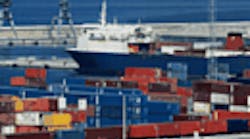The average vehicle age for trucks servicing the Port of New York/New Jersey is more than a decade old and the port is unable to maintain a strong labor force due to low pay and operational inefficiencies, according to a new study completed by professors David Bensman and Yael Bromberg of Rutgers University’s School of Management and Labor Relations.
According to the report, the average port trucker drives a vehicle that is 11 years old because they cannot afford to buy or lease low-emission, high-efficiency diesel trucks. The older vehicles pollute at least ten times more than modern trucks while consuming more fuel, costing more to maintain and requiring more frequent repairs.
With the California ports of Los Angeles and Long Beach implementing its Clean Trucks Program (CTP), requiring that trucks servicing the ports release fewer emissions, calls have come to implement similar plans at other U.S. ports.
The average vehicle age for trucks servicing the Port of New York/New Jersey is more than a decade old and the port is unable to maintain a strong labor force due to low pay and operational inefficiencies, according to a new study completed by professors David Bensman and Yael Bromberg of Rutgers University’s School of Management and Labor Relations.
According to the report, the average port trucker drives a vehicle that is 11 years old because they cannot afford to buy or lease low-emission, high-efficiency diesel trucks. The older vehicles pollute at least ten times more than modern trucks while consuming more fuel, costing more to maintain and requiring more frequent repairs.
With the California ports of Los Angeles and Long Beach implementing its Clean Trucks Program (CTP), requiring that trucks servicing the ports release fewer emissions, calls have come to implement similar plans at other U.S. ports.
“I think they could implement a similar plan [to California],” Bensman told FleetOwner. “The EPA [Environmental Protection Agency] would have to say to the Port Authority that they have to contribute towards getting the state into compliance. But it’s not going to happen unless there is a public clamor for it.”
However, Bensman noted that the port—third largest in the U.S. behind Los Angeles/Long Beach and Houston—is structured somewhat differently than other large ports as it is less involved in intermodal activity, with 85% of the containers that pass through staying in the New York metro area.
The report noted that nearly three-quarters of the approximately 7,000 port truckers that deliver and pick up containers at the ports are independent contractors who are paid on a per-load basis. They make two or three trips a day, spending an average of two unpaid hours waiting on line each trip, Bensman said.
“Since the de-regulation in 1980, port trucking has become so hyper-competitive that it makes it hard to keep a stable labor force,” Bensman said. Since they are not allowed to make deliveries for another company, the median driver reported that he changed jobs “once every couple years,” with 15% of the drivers reporting they changed jobs several times a year due to pay disputes.
In addition, drivers reported they suffered from high levels of stress, high blood pressure, asthma and work-related chronic health conditions and injuries that their employers usually take no action towards, according to the study.
Bensman said that if drivers were paid for their time rather than by load, it would force better coordination and help the drivers make enough deliveries in a day to get by, ensuring a more stable workforce.
“The truckers’ low pay and independent contractor status impede the efficiency of New Jersey’s logistics system, causing delays, unpredictable delivery times, highway congestion, congestion within the terminals, air pollution, and missing or lost containers,” the report said. “As a consequence, New Jersey’s logistics system has built in extra capacity, warehousing costs, and time cushions. The ‘just-in-time’ logistics model heralded a decade ago has given way to a ‘just-in-case’ reality. This adds billions of dollars to the cost of doing business in New Jersey.”



